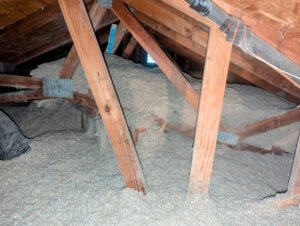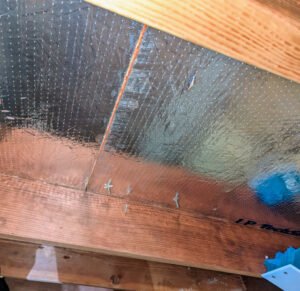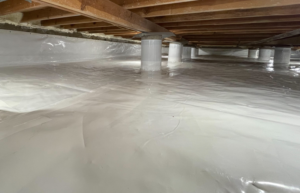Termite Related
 TAP Insulation
TAP Insulation
Thermal Acoustical Pest Control (TAP) Insulation is a loose-fill cellulose insulation treated with boric acid, offering a unique combination of benefits. The boric acid treatment makes it fire-retardant and provides pest control capabilities. For example, termites that come into contact with TAP Insulation groom themselves and ingest the boric acid, which disrupts the protozoans in their stomachs, making them unable to digest wood.
TAP Insulation is applied using a blowing process and can achieve any desired Thermal Resistance (R-value). It can be used to supplement existing insulation or completely replace it when a cleanout is necessary.
Key Benefits:
- Improved Energy Efficiency: TAP Insulation helps maintain a cooler home in summer and a warmer home in winter by providing excellent thermal resistance.
- Fire Retardant: The boric acid treatment reduces the risk of fire.
- Pest Control: Beyond termites, TAP Insulation helps control a variety of pests.
- Noise Reduction: It effectively suppresses sound, creating a quieter living environment.
- Complete Coverage: TAP conforms to the applied space, ensuring thorough coverage for optimal performance.
TAP Insulation, combined with a liquid borate treatment, is the most comprehensive method of attic termite protection.
Considerations:
While TAP Insulation provides numerous advantages, there are a few drawbacks:
- Messiness: Once installed, navigating the attic becomes challenging. Individuals exiting the attic are often covered in insulation.
- Reduced Visibility of Rafters: Identifying rafter locations can be difficult, increasing the risk of stepping through the ceiling.
Licensing Requirements:
TAP Insulation can be sold by any company offering attic insulation services, but only licensed pest control companies are qualified to explain its pest control benefits.
With its combination of fire resistance, pest control, noise suppression, and insulation capabilities, TAP Insulation is an effective and versatile choice for homeowners seeking comprehensive attic protection and energy efficiency.
 Radiant Barrier
Radiant Barrier
Heat moves from warmer areas to cooler ones through three mechanisms: conduction, convection, and radiation. For example, conduction occurs when heat travels up a metal spoon used to stir soup. Convection happens when heated air becomes lighter and rises, which explains why warm air moves upward. Radiation, on the other hand, is the transfer of heat energy from a surface to other solid objects that absorb it.
Attic insulation primarily slows down conductive heat flow and, to a lesser degree, convective heat flow. In contrast, radiant barriers reduce radiant heat transfer. They minimize the amount of heat radiating from the underside of the roof to other attic surfaces.
Radiant barriers are more commonly found in newer homes because the material is easier and more cost-effective to install during construction. Retrofitting a radiant barrier into an existing home can be challenging and expensive, making it harder to justify the cost. These barriers are especially effective in warmer climates, such as San Diego, where reducing radiant heat can make a noticeable difference.
Radiant barriers do work. I first encountered them while working for Tuff Shed, in Escondido, California. The company’s higher-end sheds included radiant barriers, and the difference was striking. Sheds with radiant barrier compared to ones without were probably 15 degrees cooler.
As a termite inspector, I regularly enter attics throughout the year. In the summer, attics can become oppressively hot, but those with radiant barriers are noticeably cooler.
The impact of radiant barriers on termites remains uncertain. One theory suggests that when attic framing becomes too hot, termites may move down into wall framing, which is harder to access and treat. If radiant barriers keep attic wood cooler, they might encourage termites to remain in more accessible areas of the attic, which could be advantageous for treatment. However, this idea is purely speculative and lacks concrete evidence.
 Vapor Barrier
Vapor Barrier
Vapor barrier is a plastic or polyethylene sheet installed on the ground or walls of the crawlspace to prevent moisture from the soil from entering the space. Moisture can rise from the ground through evaporation and create a humid environment, leading to issues such as mold growth, wood rot, pest infestations, and poor air quality.
Benefits of a Vapor Barrier:
- Moisture Control: Prevents ground moisture from seeping into the crawlspace, protecting the structural integrity of your home. Moisture is the root cause of so many structural and pest-related issues.
- Improved Air Quality: Reduces mold and mildew, which can contribute to allergies and respiratory problems.
- Energy Efficiency: Helps insulate the crawlspace, reducing heating and cooling costs.
- Termite and Fungus Prevention: Vapor barriers can make a big difference in reducing conditions that attract termites and contribute to wood decay.


